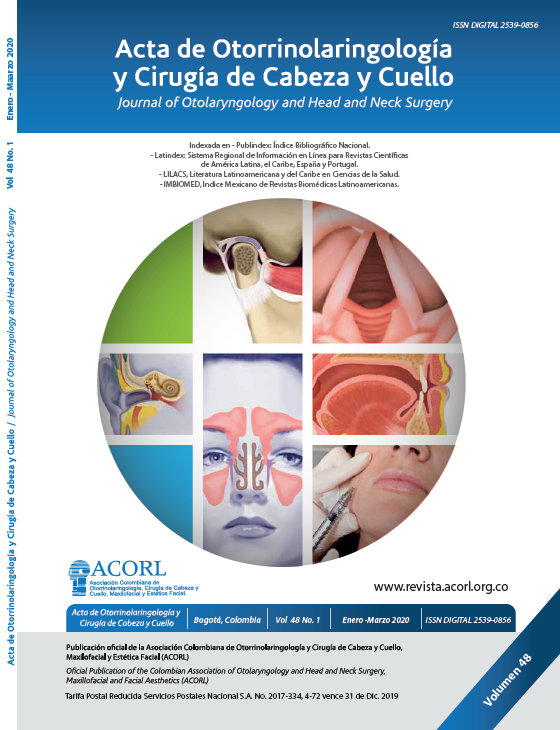Evaluation of musical perception by acoustic vs. electrical stimulation
Main Article Content
Abstract
Objective: To evaluate the differences in musical perception between electrical and acoustic sound stimulation.
Materials and methods: Adult patients with unilateral cochlear implant, healthy or mild hearing loss in the contralateral ear and rehabilitation time greater than 12 months were evaluated. Musical recognition scales, quality of life Glasgow Benefit Inventory (GBI) and identification of tone, rhythm, instruments, and songs were applied.
Results and conclusions: 6 patients were collected, ages between 37-73 years, healthy ear with a pure tone average (PTA) <40dB, speech discrimination score (SDS): 100% without changes in the postoperative period. The Implanted ear with average PTA between 40 – 58.3 dB and SDS between 70-90% post implantation. The GBI scale was applied where most of the patients obtained positive results, with a range between +41 and -13. Most of the patients improved the frequency of music-listening after implantation (4/6 patients). Half of the patients reported improvement in the role music plays in their lives. In the recognition of the tone and rhythm in the implanted ear, similar results were found after the implantation with respect to the healthy ear, with medians of 17/20 vs 16/20 in tonal patterns and 18.5 / 20 vs 18/20 in rhythmic patterns. The recognition of the songs was better with the lyrics than without the lyrics in the implanted ear, with medians of 8/8 vs 7/8. The recognition of instruments in the implanted ear was 4.5/8 vs 7.5/8 in the healthy ear.
Downloads
Article Details

This work is licensed under a Creative Commons Attribution-ShareAlike 4.0 International License.
Este artículo es publicado por la Revista Acta de Otorrinolaringología & Cirugía de Cabeza y Cuello.
Este es un artículo de acceso abierto, distribuido bajo los términos de la LicenciaCreativeCommons Atribución-CompartirIgual 4.0 Internacional.( http://creativecommons.org/licenses/by-sa/4.0/), que permite el uso no comercial, distribución y reproducción en cualquier medio, siempre que la obra original sea debidamente citada.
eISSN: 2539-0856
ISSN: 0120-8411
References
Harris RL, Gibson WP, Johnson M, Brew J, Bray M, Psarros C. Intra-individual assessment of speech and music perception in cochlear implant users with contralateral Cochlear™ and MED-EL™ systems. Acta Otolaryngol. 2011;131(12):1270-1278. doi:10.3109/00016489.2011.616225
Manrique M, Ramos A, Vernetta CA, Gil-Carcedo E, Lassaleta L, Sánchez-Cuadrado I, et al. Guía clínica sobre implantes cocleares. Acta Otorrinolaringol Esp. 2018. doi: 10.1016/j.otorri.2017.10.007
Lassaletta L, Castro A, Bastarrica M, Pérez-Mora R, Herrán B, Sanz L, et al. Percepción y disfrute de la música en pacientes poslocutivos con implante coclear. Acta Otorrinolaringol Esp. 2008;59(5):228–34. doi: 10.1016/S0001-6519(08)73300-4
Kong YY, Cruz R, Jones JA, Zeng FG. Music perception with temporal cues in acoustic and electric hearing. Ear Hear. 2004;25(2):173-185. doi:10.1097/01.aud.0000120365.97792.2f
Fujita S, Ito J. Ability of nucleus cochlear implantees to recognize music. Ann Otol Rhinol Laryngol. 1999;108(7 Pt 1):634- 640. doi:10.1177/000348949910800702
Gfeller K, Lansing CR. Melodic, rhythmic, and timbral perception of adult cochlear implant users. J Speech Hear Res. 1991;34(4):916- 920. doi:10.1044/jshr.3404.916
Brockmeier SJ, Fuster A. Cuestionario Música de Munich [Internet]. MED-EL. [acceso 19 de mayo de 2020]. Disponible en: https://s3.medel.com/downloadmanager/downloads/bridge_us/Music_Listening/en-US/MUMU_Questionnaire_ES.pdf
Sánchez-Cuadrado IP. Validación de los cuestionarios de calidad de vida “Glasgow Benefit Inventory” y “Nijmegen Cochlear Implant Questionnaire” en pacientes con implante coclear [tesis].Madrid: Universidad Autónoma de Madrid; 2015.
Buyens W, van Dijk B, Moonen M, Wouters J. Music mixing preferences of cochlear implant recipients: a pilot study. Int J Audiol. 2014;53(5):294- 301. doi:10.3109/14992027.2013.873955
Buchman CA, Dillon MT, King ER, Adunka MC, Adunka OF, Pillsbury HC. Influence of cochlear implant insertion depth on performance: a prospective randomized trial. Otol Neurotol.2014;35(10):1773- 1779. doi:10.1097/MAO.0000000000000541
David D, Werner P. Stigma regarding hearing loss and hearing aids: A scoping review. Stigma and Health. 2016;1(2):59–71.doi: 10.1037/sah0000022

